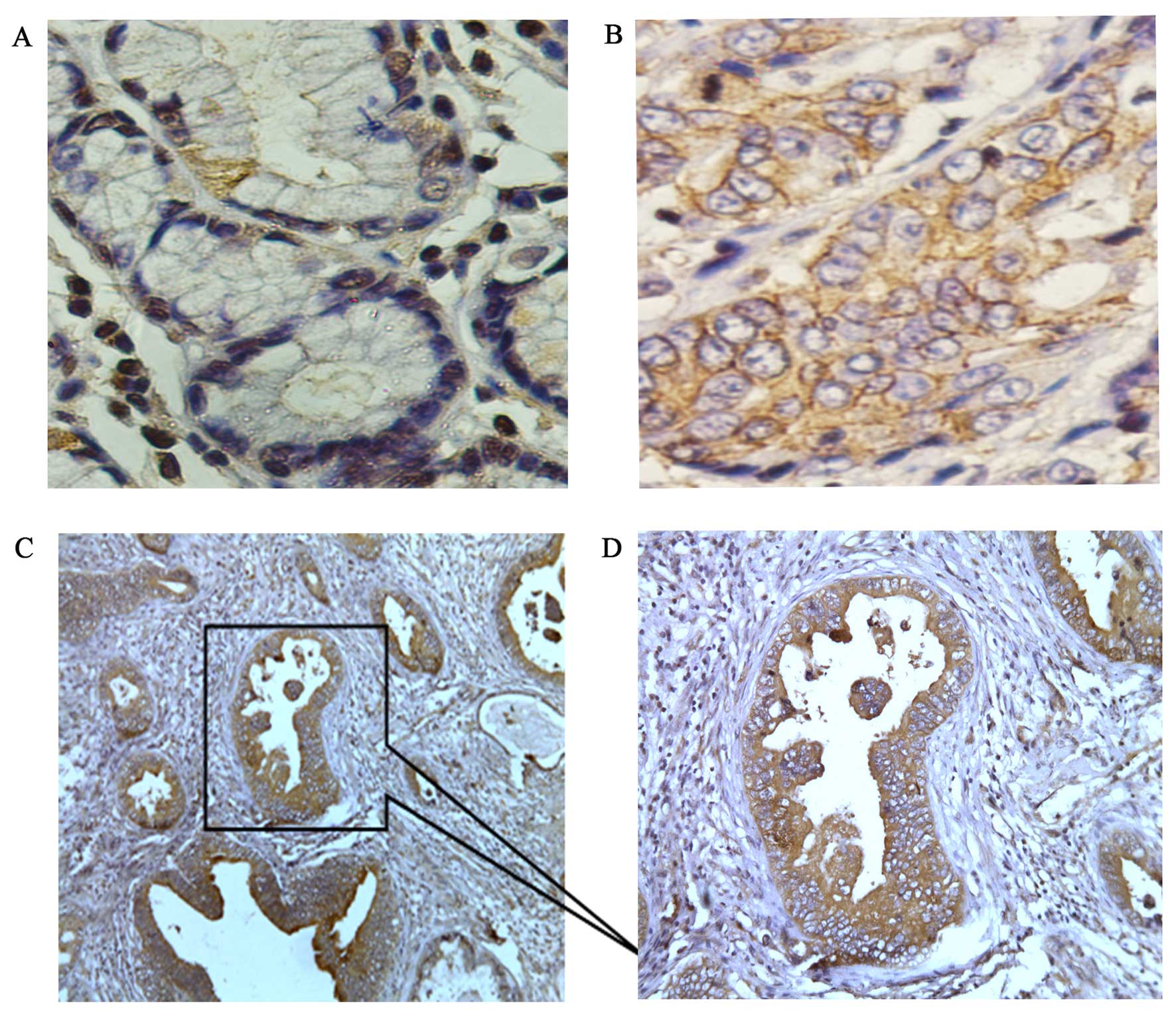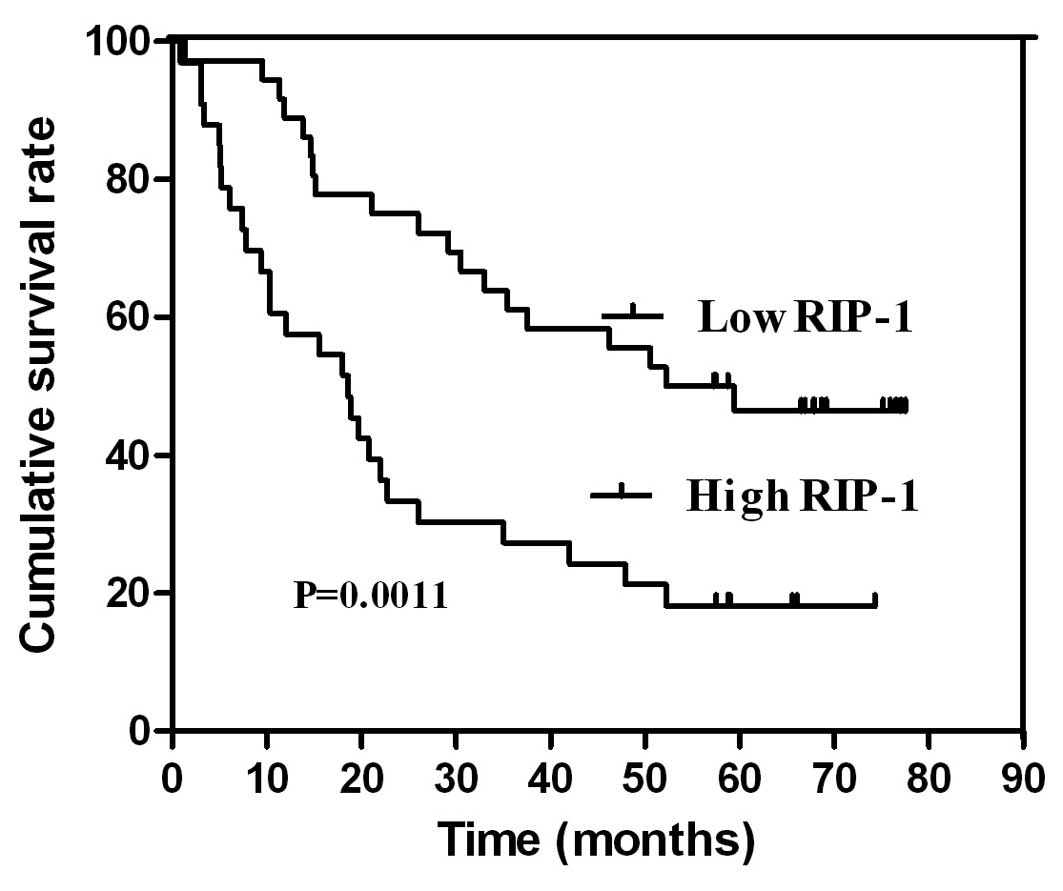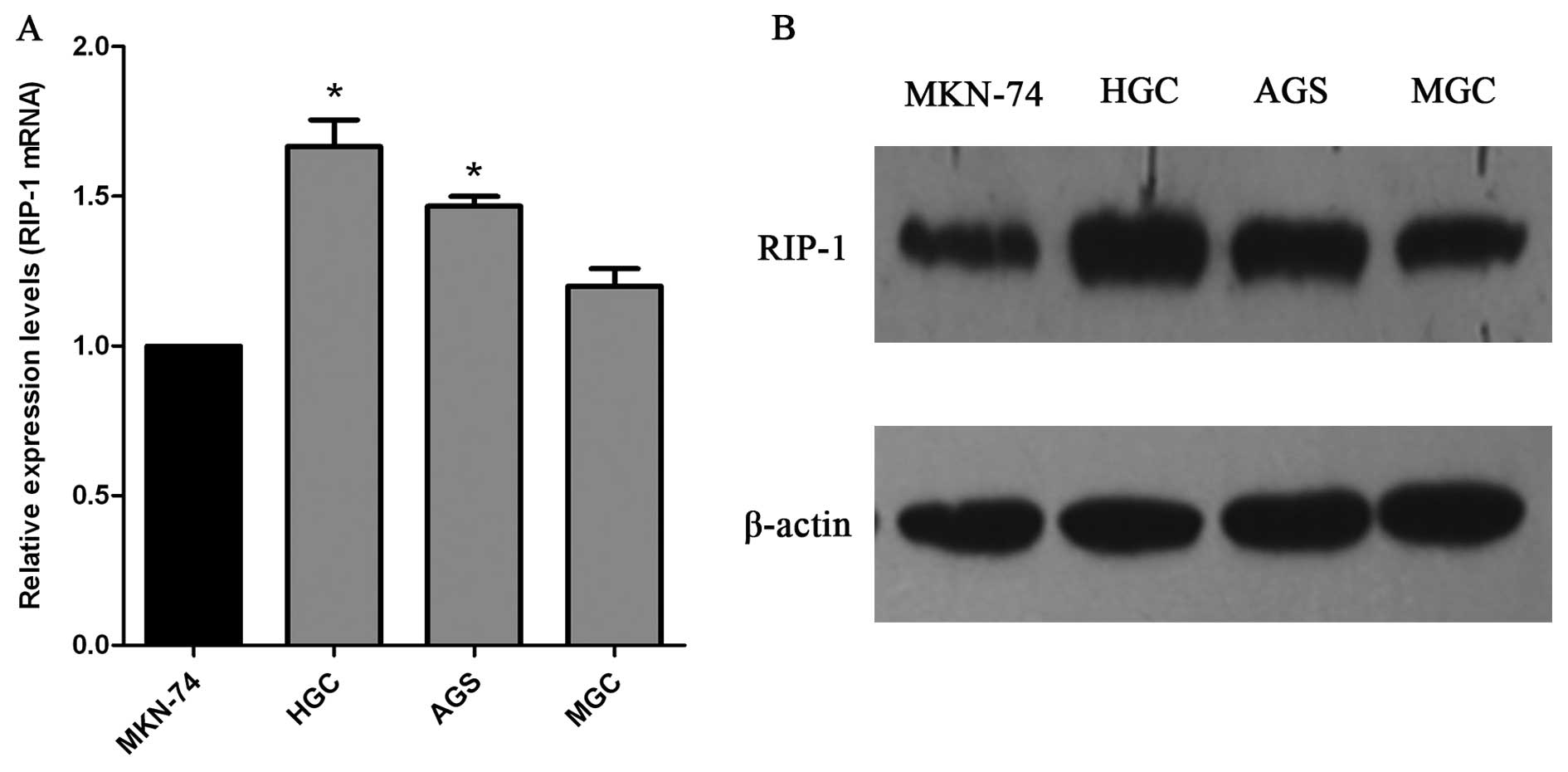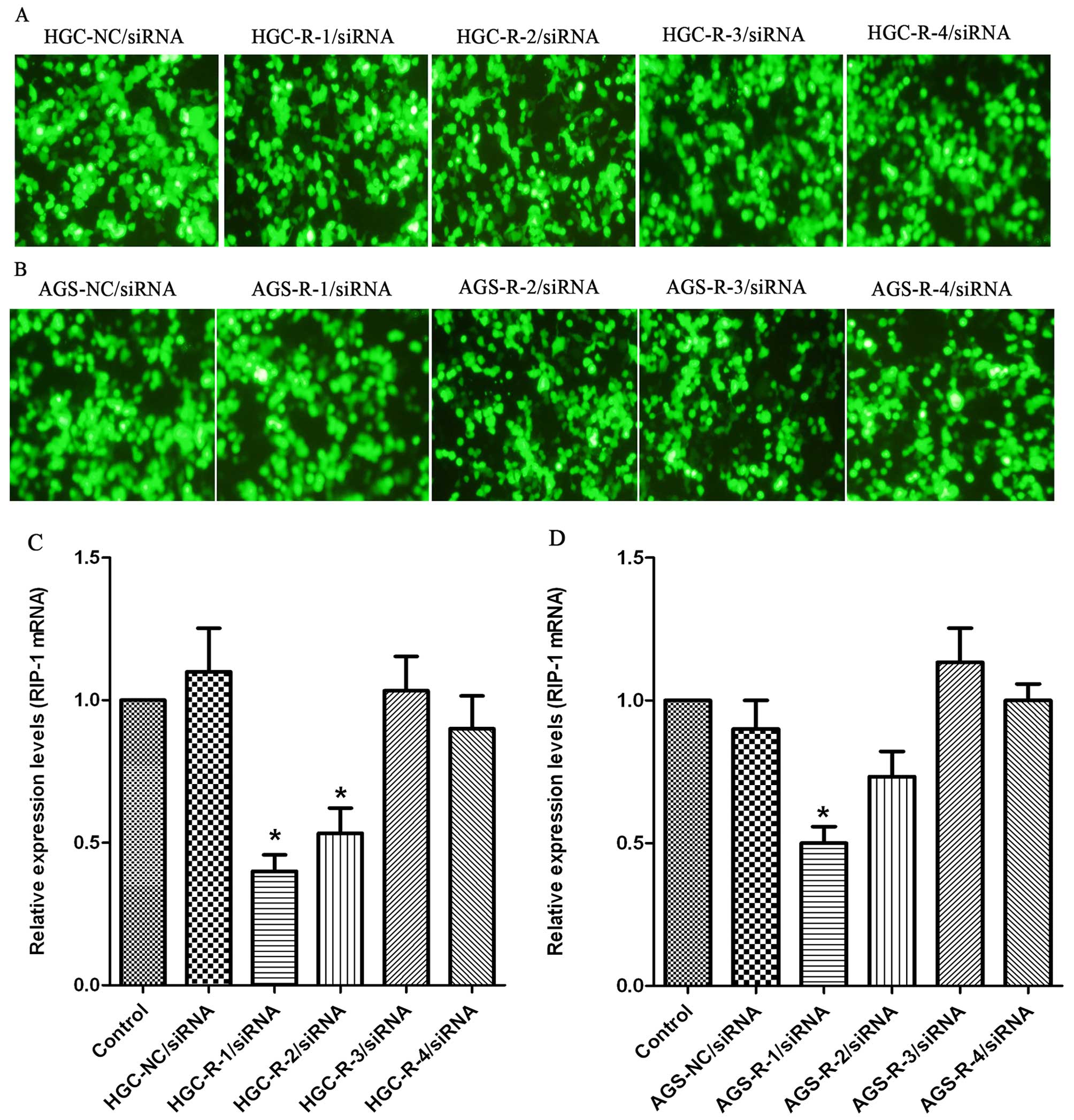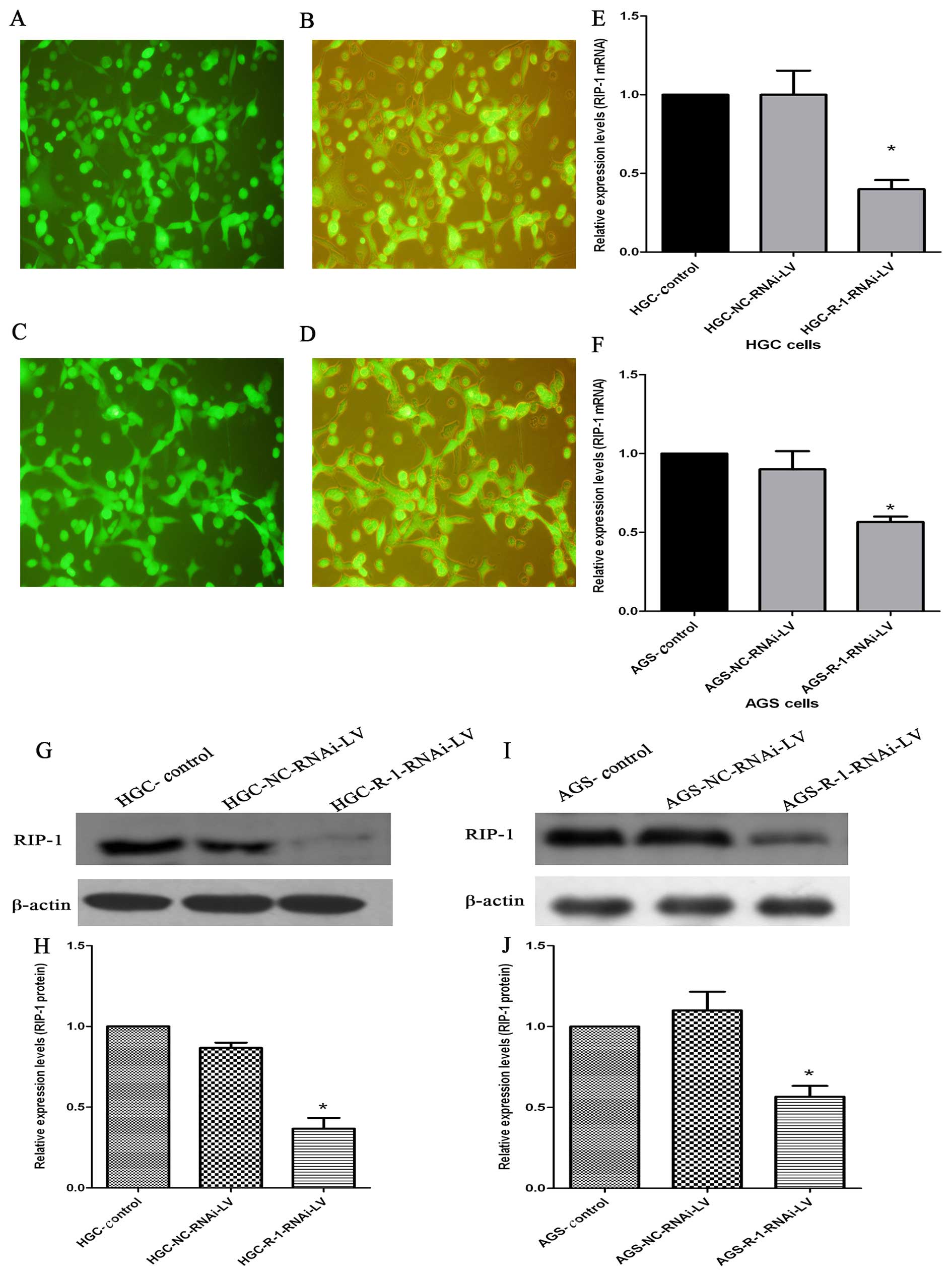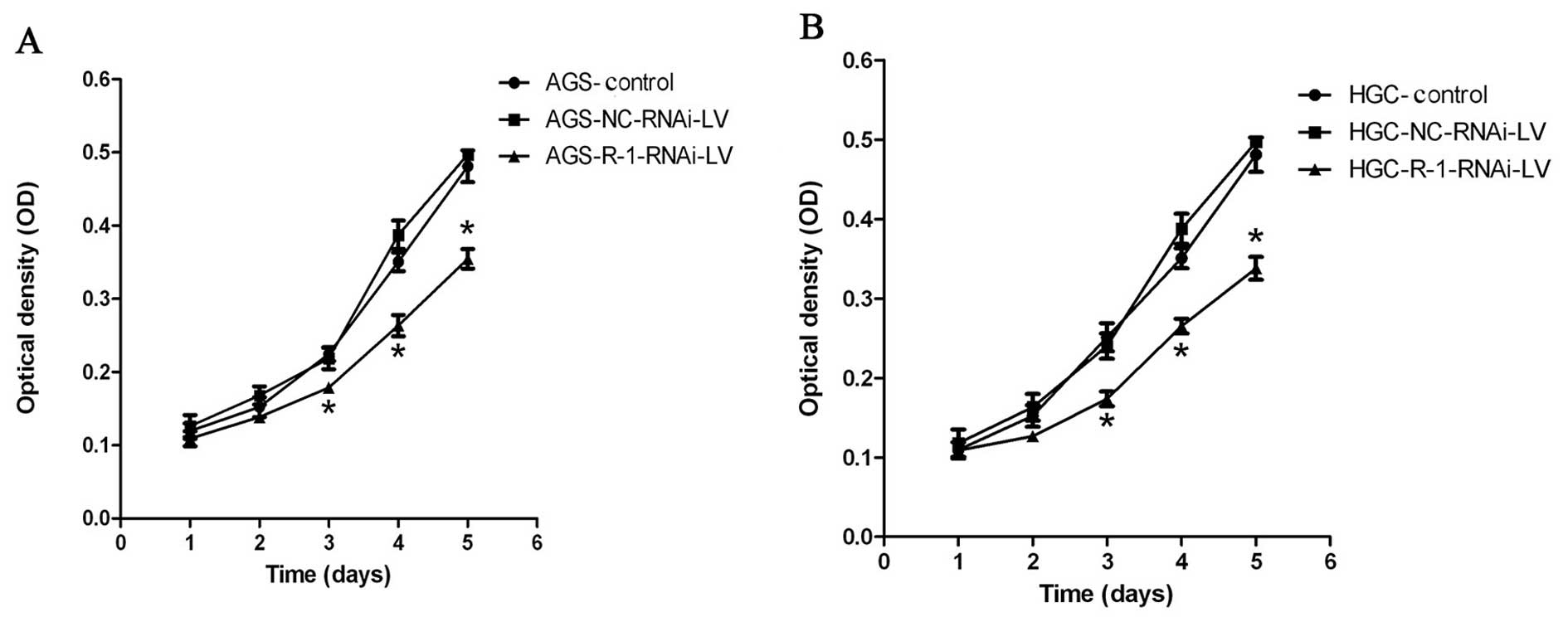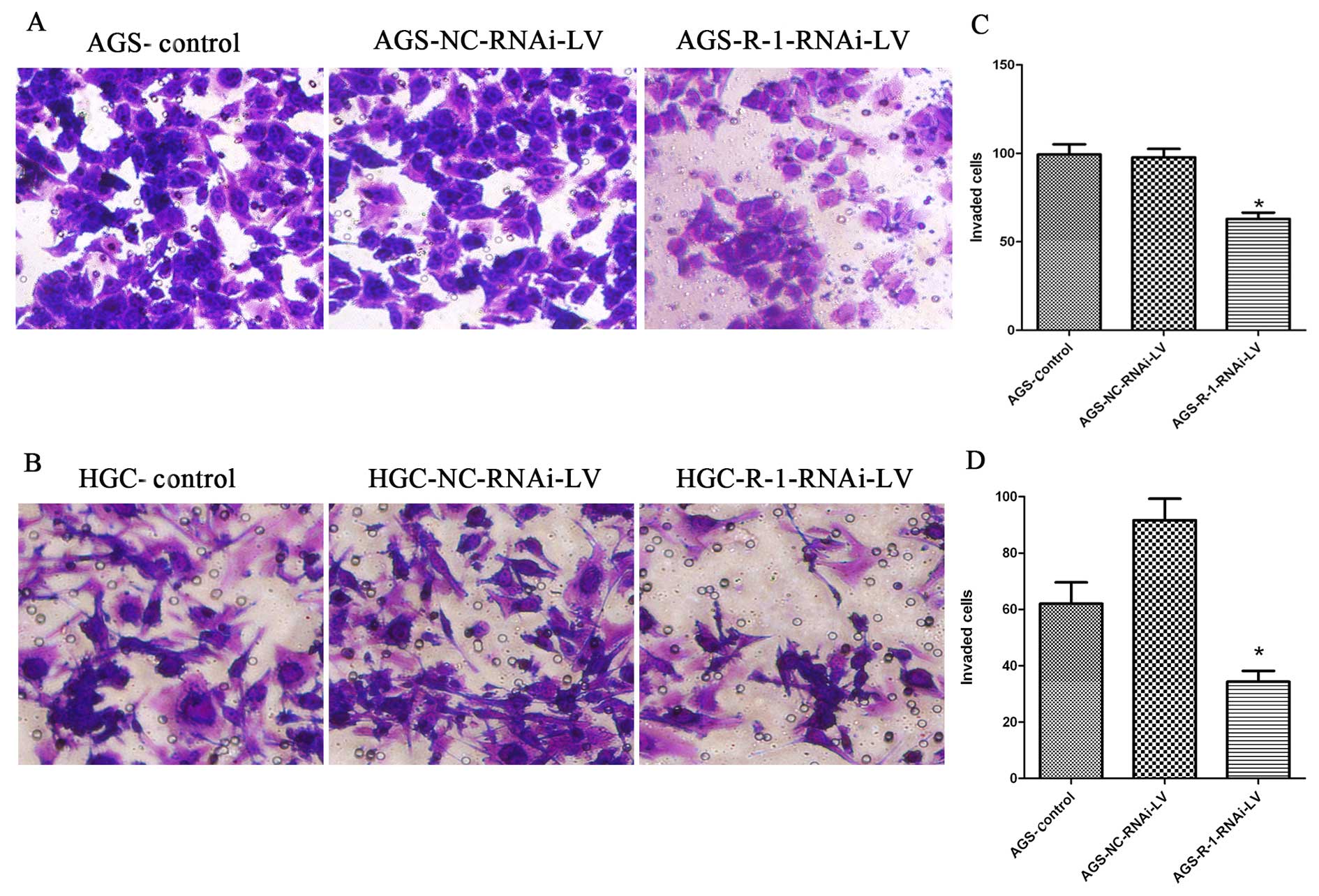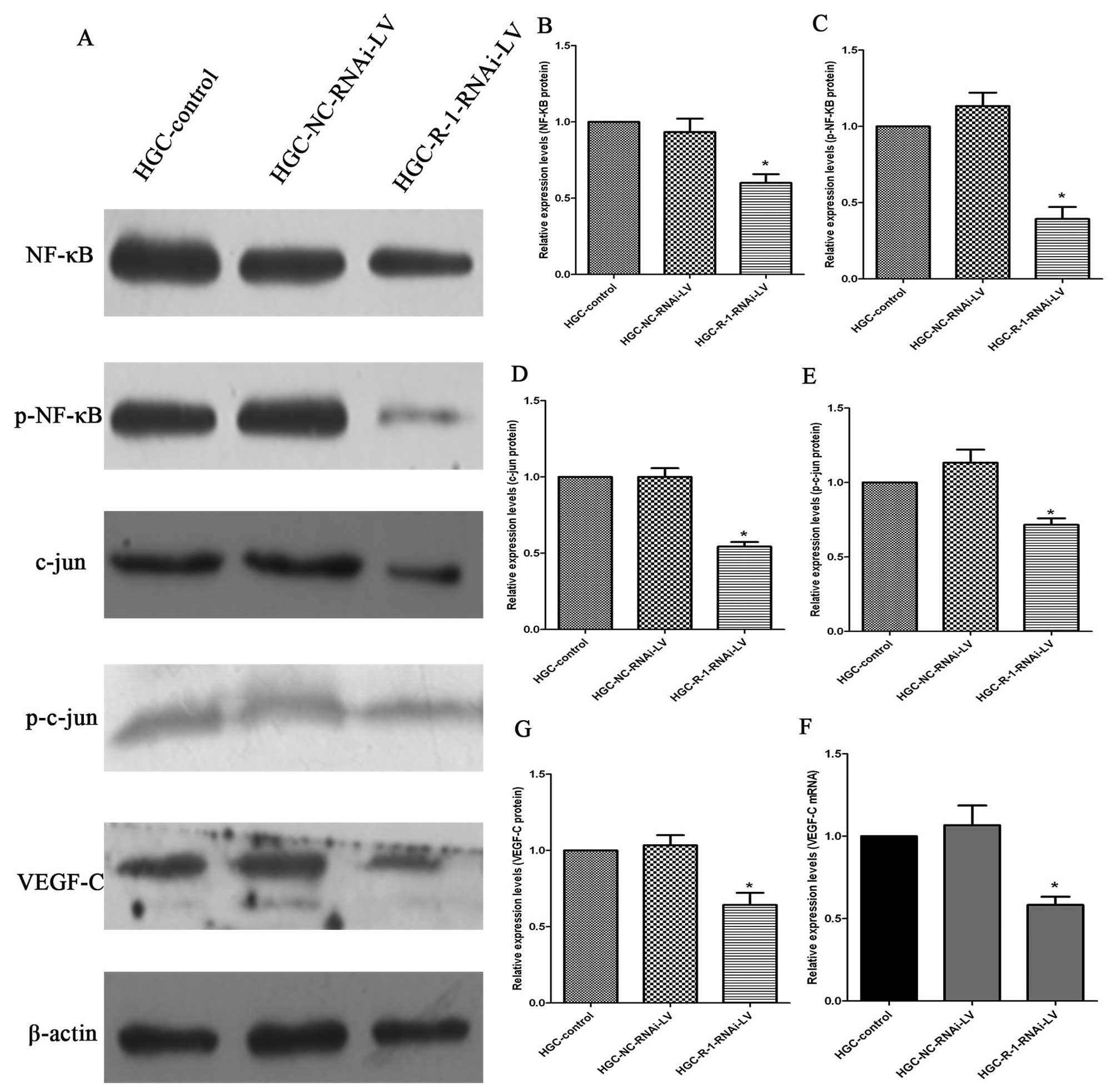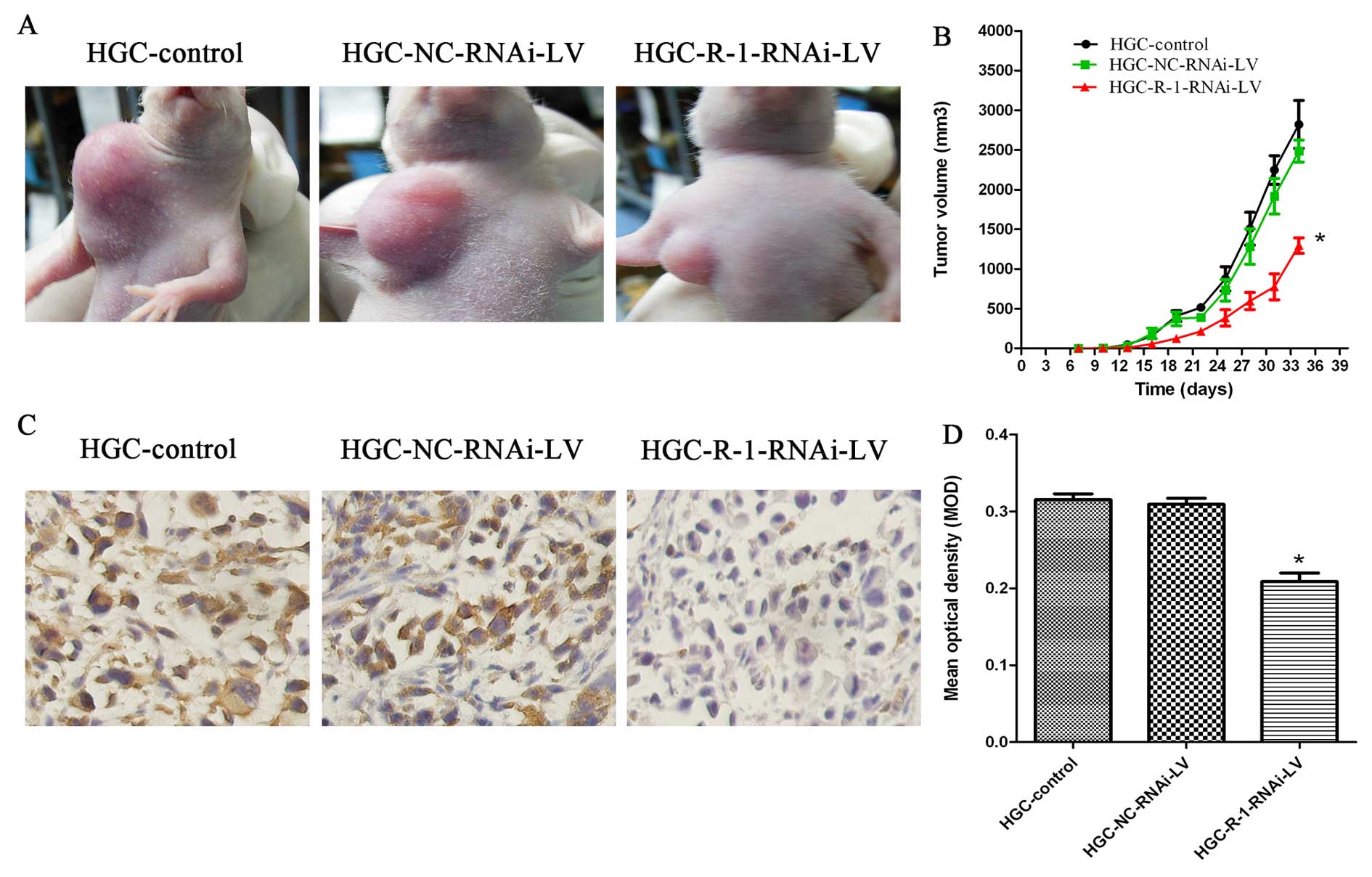Receptor-interacting protein-1 promotes the growth and invasion in gastric cancer
- Authors:
- Published online on: March 24, 2016 https://doi.org/10.3892/ijo.2016.3455
- Pages: 2387-2398
Abstract
Introduction
Gastric cancer, a highly lethal disease, is the most common malignant neoplasm of the digestive tract and the second leading cause of cancer death in the world. More than 7000,000 deaths of gastric cancer patients and nearly 1,000,000 new gastric cancer cases occur globally each year (1). Gastric cancer has an extremely poor prognosis. The relative 5-year survival rates for gastric cancer are low in most cuntries at <30% (2). Surgical resection is the only potentially curative therapy for gastric cancer. Unfortunately, only a minority of patients with gastric cancer is candidate for surgical treatment, mostly due to the high proportion of tumor that is advanced at the time of presentation (2). So, the prognosis of patients with gastric cancer remains poor. In such cases, it is necessary to study the molecular mechanisms of effect the gastric cancer progression, which may be a useful therapeutic for the treatment of gastric cancer.
As is well-known, TNF-α binds to TNFR1, then activating both the signaling pathways of live and death (3). RIP1 is recruited to the TNFR1 signaling complex within seconds of TNF-α stimulation, and become the key molecular of TNF-α-TNFR1 signaling pathway (4). RIP1 was initially described as a novel molecule with a C-terminal death domain that can interact with the death domain of one of these receptors, Fas, in a yeast two-hybrid screen (5). RIP1 plays an key role during cellular stress caused by inflammation and DNA damage. Different cell inflammation signals are transmitted by cellsurface receptors, then cascade of events are initiated by the activaed RIP1. The most important response is RIP-1 activation of transcription factor NF-κB (6) and AP-1 (7), which induces genes expression and promotes cell survival and differentiation.
Therefore, we concluded that RIP-1 is a crucial regulator of cell survival and is a pivotal component of the inflammation-signaling pathway as reported (8). Ting et al (9) shown that the RIP1 gene knockout made the TNF-α couldnot activate the NF-κB and increased the sensitivity of apoptosis of TNF-α induced in the Jurkat T cell line. Devin et al (7) found that TNF-α activated the ability of P38, ERK, and JUK decreasing induced apoptosis in the MEF cells with the knockout of the RIP1 gene.
The relationship between RIP1 and the occurrence and development of tumors are largely unknown. Park et al (10) reported that patients with glioblastomas who had increased expression of RIP1 had a significantly worse prognosis and RIP1 is overexpressed with an increase in the malignant grade of glioblastoma. A recent study reported that the K562 and HL60 leukemia cell lines with knockdown of RIP1 were sensitized by induction of apoptosis (11). Additionally, Liu et al (12) found that RIP1 is an oncogenic driver in melanoma. When RIP1 was silenced using siRNA in A549 and H460 cell lines, the migration and invasion abilities of these cells lines were reduced (13).
However, the role of RIP-1 regulating the growth and invasion of gastric cancer cells and detail mechanisms are largely unclear. Additionally, the precise mechanisms underlying RIP-1 promotion of gastric cancer growth and invasion are not well understood. Therefore, the aim of this study was to clarify the role of RIP-1 in gastric cancer. We analyzed the biological functions and underlying mechanisms of RIP-1 in human gastric cancer tissue samples and gastric cancer cell lines and addressed the role of RIP1 using a xenograft mouse model.
Materials and methods
Patient tissues and data collection
This study of human gastric cancer samples was approved by the Ethics Committee of the First Hospital Affiliated to Fujian Medical University. Seventy formalin-fixed and paraffin-embeded gastric cancer tissues, and 19 samples of normal gastric tissues that were located away from the cancer were used as contorls. The samples were provied by Pathology Department and Department of Gastrointestinal Surgery Section II of the First Hospital Affiliated to Fujian Medical University. The patient group samples were conserved during the period from 2008 to 2009, and the patient group consisted of 34 men and 36 women with a median age of 63 years. None of the gastric cancer patients included in this study had received any preoperative chemotherapy or other therapy such as radiotherapy. Postoperative chemotherapy was indicated for patients who had indications of chemotherapy with intravenous infusion of 5-fluorouracil-based chemotherapy. Follow-up was done every three months for the first 2 years and annually thereafter.
Immunohistochemistry and evalution
Immunohistochemistry staining was performed using the standard immunoperoxidase staning procedure. In brief, serial 4-μm slices were obtained from formalin-fixed and paraffin-embedded tissues specimens. Then dewaxed in xylene, rehydrated in alcohol, and incubated with fresh 3% hydrogen peroxide (H2O2) for 25 min at room temperature. Sections were antigen-retrieved by boling for 15 min in citrate buffer (pH 6.0) and followed by a wash step with phosphate buffered saline (PBS). The non-specific antigen of sections were blocked with appropriate normal serum in PBS. RIP1 mouse monoclonal anti-human antibody (1:500, Abcam Biotechnology) was diluted and placed on the sections overnight in humidified boxes at 4°C. The sections were then washed with PBS for 6 min followed by an incubation with an UltraSensitive S-P kit (Maixin-Bio, Fuzhou, China) according to the manufacturer's instructions. After exposure to stable 3, 3-diaminobenzidine for 4–6 min, slides were counterstained with hematoxylin, dehydrated, and mounted. Cells with a deposition of buffy-colored granules in the sections were scored as RIP1-positive. The expression of RIP-1 was evaluated using the Image-Pro Plus 6.0 software (Media Cybernetics, Inc. USA). Five slices were randomly selected for each group and five fields were selected for each slice. The expression of RIP-1 in each group was semiquantitatively analysed using mean optical density (MOD) = the intergral optical density (IOD) / the positive area, in 25 fields, respectively.
Cell culture
The gastric cancer cell lines MGC, MKN-74, HGC and AGS were preserved by the Key Laboratory of the Ministry of Eduction for Gastrointestinal Cancer, Fujian Medical Universtiy, Fuzhou, Fujian, China. The MGC, MKN-74 and HGC cell lines were cultured in RPMI-1640 medium supplemented with 10% fetal bovine serum (FBS) (both from Gibco, Carlsbad, CA, USA). AGS was incubated in Dulbecco's modified Eagle's medium (DMEM) supplemented with 10% FBS. All the cells were incubated at 37°C under 95% air and 5% CO2.
RNA preparation, reverse transcription, and real-time PCR amplification
Semiquantitative RT-PCR was used to detect the expression of RIP-1 gene in the gastric cancer cell lines MGC, MKN-74, HGC and AGS, respectively. Total RNA was isolated from the cultured cells grown in 6-well plates using TRIzol reagent (Invitrogen, Carlsbad, CA, USA) according to the manufacturer's instructions and quantified by UV 260/280 nm to an absorption ratio of >1.8. Total RNA (2 μg), according to the different concentrations of sample RNA, were reverse transcribed to cDNA in a final volume of 20 μl using the AVM First Strand cDNA synthesis kit (Invitrogen) following the manufacture's instructions. Additionally, they were used as cDNA template for PCR. The PCR primers used for amplification are shown in Table I. All PCRs were performed with Thermo Scientific SYBR Green qPCR kit on an Applied Biosystems StepOne Real-time PCR System. PCR conditions were: 95°C for 2 min, 95°C for 15 sec, and 60°C for 30 sec for 40 cycles. All gene transcripts were quantified by the 2−ΔΔCt method.
Western blot analysis
Western blot analysis and detection of the blotted product were carried out as described previously (14). The following primary antibodies were used from the companies as listing, respectively: RIP-1 mouse monoclonal anti-human antibody (1:1,000), VEGF-C rabbit polyclonal anti-human antibody (1:1,000), c-jun (AP-1) monoclonal rabbit anti-human antibody (1:1,000), and p-c-jun (p-AP-1) monoclonal rabbit anti-human antibody (1:1,000) (all from Abcam Biotechnology), nuclear factor-κB (NF-κB) (p65) monoclonal mouse anti-human antibody (1:500), p-NF-κB (p-p65) monoclonal mouse anti-human antibody (1:500) (both from Cell Signaling Technology, Danvers, MA, USA), β-actin monoclonal mouse anti-human antibody (1:1,500) (from Santa Cruz Biotechnology, Inc., Santa Cruz, CA, USA).
RIP-1 siRNA plasmid constuction and transfection
According to the siRNA design principle, four suitable siRNA target sequences (R-1, R-2, R-3 and R-4), from human RIP-1 gene GenBank accession no. NM_003804, were synthesized as follows, respectively: R-1, GCACAAATACGAACTTCAA; R-2, GGCCAATTCCAAGTCATAT; R-3, TACAACAGAGAGGAGGAAA; and R-4, TTGTGATAATGACTTCCA. A small hairpin RNA (shRNA) of human RIP-1 in a phU6 gene transfer vector and the negative control (NC) sequence encolding an enhanced green fluorescent protein (EGFP) sequence with the puromycin resistance were constructed by Genechem Co. Ltd. (Shanghai, China). Additionally, all the plasmids were verified by DNA sequencing. The AGS and HGC cells were cultured in appropriate medium supplemented with 10% FBS. When the AGS and HGC cells were at ~90% confluency, we transfected the plasmids into these cells. We used Lipofectamine 2000 (Invitrogen) to transfect cells according to the manufacturer's instructions. We used a microscope to observe the transfection efficiency by counting the percentage of cells that were EGFP-positive.
Construction of lentiviral vetors and infection
In order to create better stable transfection for later experiments, we constructed lentiviral-mediated siRNA targeting RIP-1 vector. We constructed lentiviral vectors for human RIP-1 small hairpin RNA (shRNA) encoding a green fluorescent protein (GFP). The lentivirus vectors containing RIP-1 shRNA were constructed by ligating the digested pGCSIL-GFP and the RIP-1 shRNA PCR product and then verified by DNA sequencing. ShRNA for the negative controls was preserved in our lab. AGS and HGC cells were plated in 6-well plates with appropriate medium supplemented with 10% FBS overnight. When these cells were at approximately 35% confluent, they were used in siRNA virus infection. The multiplicity of infection of (MOI) = 50 was appropriate quantity of virus infection and 1 ml complete medium was added to 8 mg/ml polybrene and mixed with cells and incubated for 12 h at 37°C. Then, the cells were incubated in fresh complete medium containing 10% FBS for 24 h. Microscope was used to confirm the infection efficiency by observing the GFP-positive cells.
Cell proliferation assay
Cell proliferation was assessed by MTT assay. Three groups of cells (blank control group, NC-RNAi-LV group and R-1-RNAi-LV group) were seeded into 96-well plates at density of 103 cells/well with 100 μl of medium supplemented with 10% FBS. The proliferative activity was determined after 1, 2, 3, 4, and 5 days by the addition of 10 μl of sterile 3-(4,5-dimethylthiazol-2-yl)-2, 5-diphenyltetrazolium bromide (MTT) (5 mg/ml; Sigma) to each well. The reaction was terminated after 4 h of incubation at 37°C through the addition of 100 μl of dimethyl sulfoxide (DMSO; Sigma). The optical density (OD) value was obtained by measuring absorbance at a wavelength of 450 nm. Each well test was repeated 6 times.
In vitro cell invasion assay
Invasion assays were performed using Transwell 24-well plates with 8-μm polycarbonate membranes (BD Biosciences). Briefly, the upper side of the membranes was coated with Matrigel matrix (20 μg/well) and the membranes were then air-dried for 1 h of incubation 37°C. The lower side of the membranes was coated with 5 μg fibronectin (BD Biosciences). To test the ability of cell invasion, blank control group, NC-RNAi-LV group and R-1-RNAi-LV group gastric cancer cells (2×105) in 200 μl of RPMI-1640 (DMEM for AGS cells) medium with 2.5% FBS were placed in the upper chamber. The lower chamber was filled with 700 μl RPMI-1640 (DMEM for AGS cells) medium with 10% FBS as the chemoattractant. The invasion chamber was incubated for 8 h at 37°C and 5% CO2. The cells on the upper surface of the membrane were removed by gentle scrubbing with a cotton swab. Membranes were fixed in a stationary liquid of 95% ethanol and 5% acetic acid for 30 min and stained with crystal violet. The number of cells on the lower surface of the membrane in 5 random visual fields (×400) was then counted using a bright field light microscope. Each assay was repeated in triplicate.
Animal experiments
Male four to six-week-old athymic BALB/c nu/nu mice were obtained from the Shanghai SLAC Laboratory Animals Co., (Shanghai, China) and kept in the Experimental Center of the Fujian Medical University. All the mice were handled according to the recommendations of the institutional guidelines and were approved by the Ethics Committee of the Medical Faculty of the Fujian Medical University. Blank control group, NC-RNAi-LV group and R-1-RNAi-LV group were randomly divided into three groups using 15 mice (five mice/group) for the subcutaneous gastric cancer nude mouse model. Three groups of different gastric cancer cells (106) in 100 μl serum-free medium were seeded subcutaneously into the upper flank region of the nude mice. Tumor growth was monitored and measured in two dimensions (width and length respectively) every 3 days. The size of tumor growth was estimated using the formula = width2 (mm2) × length (mm)/2 (the width and length are the shortest and longest diameters of the subcutaneous tumor). After 5 weeks, nude mice were sacrificed and the tumors were collected and weighed immediately. Then all the samples were fixed in 10% formalin solution for the immunohistochemical analysis.
Statistical analysis
The statistical analysis used GraphPad Prism 5 software. Data were analyzed by the one-way ANOVA or Student's t-test. The data were expressed as the means ± standard deviation (SD). Survival curves were calculated by the Kaplan-Meier method and compared by using the log-rank test. A P-value <0.05 was considered to indicate a statistically significant difference.
Results
Analysis of RIP-1 expression in patients with gastric cancer by immunohistochemistry staining, clinicopathologic factors and prognosis
We evaluated the expression of RIP-1 in 70 clinical samples from gastric cancer patient and 19 normal gastric tissues distant from the cancer site using immunohistochemistry. In the normal gastric tissues, low levels of RIP-1 expression were detected (Fig. 1A); but, in the gastric cancer tissues high levels of expression of RIP-1 were found (Fig. 1B). The MOD of RIP-1 in the normal gastric tissues (0.1478±0.1346) was markedly lower than gastric cancer tissues (0.3576±0.0961; P<0.001; Table II). Thus, RIP-1 was overexpressed in the gastric cancer tissues. Importantly, the RIP-1 immunoreactivity was positive at the site of invasion, but little or no immunoreactivity was detected at the parts of interstitial substance (Fig. 1C and D). This suggested that RIP-1 overexpression may promote gastric cancer invasion.
Table IIImmunohistochemistry results of the expression of RIP-1 in gastric cancer samples, and normal gastric tissues. |
Table III shows the relationship between RIP-1 expression and select clinicopathological parameters. RIP-1 expression did not vary significantly with age, gender, tumor size and histological grade; however, there was a significant relationship between RIP-1 overexpression and clinical stage (I–II vs. III–IV; P=0.031), lymph node metastasis (no vs. positive; P=0.036) and Helicobacter pylori (negative vs. positive; P=0.0312).
Survival and prognostic analysis
The expression levels of RIP-1 were positively correlated with the prognosis of gastric cancer patients. The study samples were split into two groups according to the MOD expression levels: a low RIP-1 expression levels group (<0.3011, which is the average MOD values of 70 gastric cancer patients of tissues) and a high RIP-1 expression levels group (≥0.3011). Additionally, the patients with high expression of RIP-1 had very discouraging prognosis; however, the patients with low expression of RIP-1 had a better prognosis. Thus, the survival and prognosis of the low expression of RIP-1 group was significantly longer than the high expression of RIP-1 group (P<0.05) (Fig. 2).
Expression of RIP-1 mRNA and protein in gastric cancer cell lines
We used qRT-PCR and western blot technology to detect the expression of RIP-1 in human gastric cancer cell lines (MGC, MKN-74, HGC, and AGS). RIP-1 mRNA was detected in all four cell lines by qRT-PCR. In addition, expression of RIP-1 protein in all four cell lines was confirmed. The expression quantity of RIP-1 mRNA and protein in HGC and AGS cells was higher compared with the MGC and MKN-74 cells (Fig. 3). Thus, we used the HGC and AGS cells to further evaluate the role of RIP-1 in gastric cancer.
Expression of RIP-1 mRNA after siRNA transfection
The RNAi effect of silencing RIP-1 gene in the HGC and AGS cells was assessed. The DNA sequencing results verified that RIP-1 siRNA plasmid construction was successful. To determine the level of RIP-1 expression levels 72 h after transfection in HGC and AGS cells we used qRT-PCR. Expression of the siRNA plasmids vectors (NC/R-1/R-2/R-3/R-4/siRNA) enhanced green fluorescent protein (EGFP) 72 h after transfection, as shown by fluorescence microscopy, in the HGC and AGS cells (Fig. 4A and B). qRT-PCR revealed a decrease in RIP-1 mRNA in siRNA-transfected cells. The R-1/siRNA plasmid vector resulted in a higher suppression of the levels of RIP-1 mRNA expression than other vectors (R-2/siRNA, R-3/siRNA, and R-4/siRNA), while non-transfected and NC/siRNA vectors had no effect on the levels of RIP-1 mRNA expression in the HGC and AGS cells (Fig. 4C and D). Because semi-quantitative analysis by qRT-PCR showed that there was marked inhibition between R-1/siRNA and non-transfected siRNA groups in the HGC and AGS cells, we selected R-1/siRNA sequence to knock down the RIP-1 in our further studies.
Expression of RIP-1 mRNA and protein after R-1/siRNA lentiviral vectors infection
We used lentiviral-mediated R-1/siRNA targeting RIP-1 vector to improve the stable transfection for the next experiment. Transfection efficiency was quantified by counting the cells under a fluorescent microscope 72 h after infection, and the efficiency of HGC and AGS cells were >80% (Fig. 5A–D). The qRT-PCR showed that the expression of RIP-1 mRNA was significantly inhibited after infection in HGC and AGS cells. Compared with the control group and NC-RNAi-LV group, the R-1-RNAi-LV group showed relatively lower expression of RIP-1 mRNA in HGC and AGS cells (Fig. 5E and F). In accordance with mRNA, western blotting revealed that RIP-1 protein expression was suppressed in the R-1-RNAi-LV group compared with the control group and NC-RNAi-LV group in HGC and AGS cells. There were distinct densitometric differences between R-1-RNAi-LV group and control group and NC-RNAi-LV group in HGC and AGS cells (Fig. 5J, H, J and K).
RIP-1 promotes HGC and AGS cell proliferation and invasion in vitro
To experimentally address the biological function of RIP-1 in gastric cancer cells, we analyzed the effect of lentivirus-mediated RIP-1 siRNA on HGC and AGS cell proliferation and invasion by MTT assay and cell invasion assay, respectively. MTT experiment results showed that compared to control group and NC-RNAi-LV group, the cell proliferation of the R-1-RNAi-LV group was slower in HGC and AGS cells (Fig. 6). The cell viability of R-1-RNAi-LV group was decreased when compared with control group in both gastric cancer cell lines. The results from cell in vitro invasion indicated that the numbers of cells that penetrated the basal membrane from the R-1-RNAi-LV group was significantly less than the blank control group, which was similar to the number of cells from the NC-RNAi-LV group in HGC and AGS cells (Fig. 7).
RIP-1 knockdown reduces the activity of NF-κB (p65) and c-jun (AP-1) and decreases VEGF-C gene expression
To investigate the mechanisms of RIP-1 silencing responsible for the decrease in proliferation and invasion, we assessed the changes in levels of NF-κB (p65), p-NF-κB (p-p65), c-jun (AP-1), p-c-jun (p-AP-1) and VEGF-C protein and VEGF-C mRNA; these factors are vital to the growth and invasion of cancer cells. Western blot analysis revealed that NF-κB (p65), p-NF-κB (p-p65), c-jun (AP-1), p-c-jun (p-AP-1) and VEGF-C protein levels in the R-1-RNAi-LV cells decreased compared with the control NC-RNAi-LV and in HGC cells (Fig. 8). The changes in VEGF-C mRNA expression in the three groups were the same as the levels of VEGF-C protein in HGC cells (Fig. 8F).
RIP-1 promotes gastric cancer tumor growth in nude mice with subcutaneous xenograft tumors
To address the impact of RIP-1 expression on gastric cancer tumor biology in vivo, three groups (HGC-control, HGC-NC-RNAi-LV, and HGC-R-1-RNAi-LV groups) of HGC cells were subcutaneously xenografted onto nude mice. Nude mice were all successfully established in the subcutaneous mouse model. None of the mice had ascites or metastasis to the liver, lungs, or lymph nodes at the time of autopsy. At the end of the 5-week experimental period, the size of the subcutaneous xenograft tumor showed significant differences between the HGC-R-1-RNAi-LV and HGC-NC-RNAi-LV groups, which was similar to the HGC-control group. We found that xenograft growth was markedly slower from the second week until the day on which the mice were sacrificed (Fig. 9A and B). Because RIP-1 expression was reduced in the HGC-R-1-RNAi-LV cells, we used immunohistochemistry to analyze the expression of RIP-1 in the nude mice. Compared with the HGC-control and HGC-NC-RNAi-LV groups, the levels of RIP-1 expression were significantly reduced in the HGC-R-1-RNAi-LV group (Fig. 9C and D).
Discussion
Aberrant activation of survival signaling pathways plays a very important role in cancer development, and progression (15). The activation of NF-κB and AP-1 in human cancer is common, and the activation promotes growth and invasion of cancer cells (7,16–19). RIP-1 is a crucial molecule for NF-κB and AP-1 signaling in inflammation and cell survival (16–19). RIP-1 consists of N-terminal kinase domain, an intermediate domain, a RIP homotypic interaction motif, and a C-terminal death domain motif (20). RIP-1 is a kinase with important roles in inflammation, cell survival, and cell apoptosis (20), mediating both cell survival and death signaling.
Upon TNFR1 stimulation, RIP-1, along with other proteins including TRADD, TRAF2, cIAP1, and cIAP2, are recruited to form the prosurvival complex I (21,22). Then k63 polyubiquitin and linear ubiquitin chains linked to RIP-1 serve as substrates for binding the TAB/TAK1 complex and NEMO, leading to activation of NF-κB and AP-1, which plays an important role in regulating many cellular processes (7,16,23,24).
However, the complicated functions and mechanisms of RIP-1 regulated cell signaling pathways are largely unknown. Additionally, many details pertaining to the role of RIP-1 in cancer cells are unclear. Some recent reports address the functions of RIP-1 in gioblastomas (10), leukemia (11), lung cancer (13), and melanoma (12). Additionally, our study team reported that RIP-1 promotes the proliferation and invasion via the signaling pathways of RIP-NF-κB/AP-1-VEGF-C in gallbladder cancer cells (25). However, the expressions and roles of RIP-1 in gastric cancer are still unknown. The specific interactions between RIP-1 and cancers are largely unclear, so we investigated the biological functions and underlying mechanisms in vitro and in vivo in gastric cancer.
In this study, we first demonstrated the roles of RIP-1 in promoting growth and invasion of human gastric carcinoma. We used immunohistochemical techniques to evaluate the expression of RIP-1 in 70 gastric cancer specimens and 19 samples of normal gastric tissues which were locted distant from the cancer site. RIP-1 is overexpressed in gastric cancer tissues, and RIP-1 has low expression in normal tissues. Increased expression of RIP-1 is common in gastric cancer tissues. This suggested that RIP-1 may be an important molecule and be of clinical significance in prognosis. The survival and prognosis of the low expression of RIP-1 group was significantly longer than the high expression of RIP-1 group. This agreed with Park et al (10) who reported that RIP-1 is an independent prognostic factor in glioblastomas. We found that the RIP-1 immunoreactivity was positive at the site of invasion, but little or no immunoreactivity was detected at the parts of interstitial substance and the expression of RIP-1 was markedly correlated with the clinical stage of gastric cancer patients, which suggested that RIP-1 may promote gastric cancer invasion and growth. We also found that RIP-1 expression is significantly increased in the gastric cancer patients with Helicobacter pylori infection. The reason may be Helicobacter pylori infection inducing inflammation and thus increasing the expression of RIP-1 (26). We also found that the RIP-1 expression was high in the gastric cancer patients with lymph node metastasis. Additionally, the VEGF-C is an important factor in the gastric cancer lymph node metastasis (27,28). It was reported that VEGF-C could promote tumor cells to invade the interstitial substance (29).
RNAi technology has served as the most widely used techique for gene knockdown and provide a method to study gene expression and function (30). In addition, siRNA allows us to target any gene with greater selectivity, stability and efficiency (31) and plays an important role in the study of gene function in human cancer (32). Thus, we used siRNA to evaluate the effect of suppressing the RIP-1 gene in gastric cancer in vitro and in vivo. In this study, we successfully selected R-1/siRNA as the most effective siRNA to knock down RIP-1 expression after four RIP-1 siRNA plasmid transfections in HGC and AGS cells. RIP-1 mRNA and protein was inhibited by R-3-RNAi-LV vector in HGC and AGS cells. In vitro, knockdown of the RIP-1 expression by siRNA suppressed the proliferation and invasion of HGC and AGS cells. Our results agree with those of Azijli et al (13) who reported that knockdown the RIP-1 gene inhibited the migration and invasion in A549 and H460 cell lines. Our laboratory showed that the proliferation and invasion were significantly suppressed in the gallbladder cancer cells, when silencing the RIP-1 gene expression in the tumor cells (25). The results suggest that RIP-1 can affect the biological characteristics of tumor cells in gastric cancer.
To investigate the mechanisms underlying RIP-1 promotion of growth and invasion of HGC and AGS cells, we used western blot analysis to evaluate the changes of expression of NF-κB (p65), p-NF-κB (p-p65), c-jun (AP-1), p-c-jun (p-AP-1) and VEGF-C protein in HGC cells. These proteins are vital to the survival of gastric cancer cells and very important in the inflammation signaling pathways, in which RIP-1 can activate the activity of NF-κB (p65), p-NF-κB (p-p65), c-jun (AP-1), p-c-jun (p-AP-1) (7,16–19). In this study, the expression of NF-κB (p65), p-NF-κB (p-p65), c-jun (AP-1), p-c-jun (p-AP-1) and VEGF-C protein were decreased in the HGC-R-1-RNAi-LV group cells compared with HGC-control group and HGC-NC-RNAi-LV group cells. These results suggested that RIP-1-NF-κB/AP-1 signaling pathway may regulate the expression of VEGF-C.
In our murine model gastric cancer, we found that the mice of HGC-R-1-RNAi-LV group the growth of subcutaneous xenograft tumors was much slower compared with the subcutaneous xenograft tumors of mice of HGC-control group and HGC-NC-RNAi-LV group. In our in vivo model of gastric cancer, we did not find liver, lung or lymph node metastasis, and ascite had not developed. This is because the subcutaneous xenograft gastric tumor model can not provide a suitable microenvironment for tumors (33). Therefore, we will establish an orthotopic xenograft model of gastric cancer to futher study RIP-1 and its influence on the biological behavior of gastric cancer.
In conclusion, this study demonstrated that the expression of RIP-1 in the gastric cancer tissues was significantly higher than the expression in the normal gastric tissues. Additionally, RIP-1 immunoreactivity was positive at the site of invasion, but little or no immunoreactivity was detected at the gastric cancer parts of the interstitial substance. The survival rate was poor in RIP-1 high expression of patients with gastric cancer. Futhermore, the RIP-1 expression in the gastric cancer cell lines were general. Additionally, we provided evidence that endogenously secreted RIP-1 contributed to the proliferation and invasion of HGC and AGS cells. We also found that the RIP-NF-κB/AP-1-VEGF-C signaling pathways have a crucial role in the regulation of the biological functions of HGC and AGS cells. We verified the relationship between RIP-1 overexpression and the growth of gastric cancer using a mouse model. Together, our data indicate that RIP-1 promote the growth and invasion of gastric cancer in vitro and in vivo. Additionally, our results provide evidence that targeting RIP-1 may be useful in the treatment of gastric cancer.
Acknowledgements
This study was supported by the Key Project of Science and Technology Reserch Program in Fujian Province (no. 2012B002), the Fujian Provincial Natural Science Foundation (no. 2014J01309), the Backbone Teacher Project of Fujian Medical University (no. JGG200716), China Non intervention Gastric Cancer Registration Survey Clinical Research Projects (no. QT-201403), the Ministry of Health Medicine Science and Technology Development and Research (no. W2013FZ08) and the National Clinical Key Specialty Construction Project (General Surgery) of China.
References
|
Ferlay JSI, Ervik M, et al: GLOBOCAN 2012v1.0, Cancer Incidence and Mortality Worldwide. IARC CancerBase No. 11 (Internet). International Agency for Research on Cancer; Lyon: 2013, http://globocan.iarc.fr. Accessed Apr 25, 2014 | |
|
Carneiro F: Stomach cancer. World Cancer Report 2014. Steward B and Wild CP: International Agency for Research on Cancer; Lyon: pp. 383–391. 2014 | |
|
Waters JP, Pober JS and Bradley JR: Tumour necrosis factor in infectious disease. J Pathol. 230:132–147. 2013. View Article : Google Scholar : PubMed/NCBI | |
|
O'Donnell MA and Ting AT: RIP1 comes back to life as a cell death regulator in TNFR1 signaling. FEBS J. 278:877–887. 2011. View Article : Google Scholar : PubMed/NCBI | |
|
Stanger BZ, Leder P, Lee TH, Kim E and Seed B: RIP: A novel protein containing a death domain that interacts with Fas/APO-1 (CD95) in yeast and causes cell death. Cell. 81:513–523. 1995. View Article : Google Scholar : PubMed/NCBI | |
|
Hur GM, Lewis J, Yang Q, Lin Y, Nakano H, Nedospasov S and Liu ZG: The death domain kinase RIP has an essential role in DNA damage-induced NF-kappa B activation. Genes Dev. 17:873–882. 2003. View Article : Google Scholar : PubMed/NCBI | |
|
Devin A, Lin Y and Liu ZG: The role of the death-domain kinase RIP in tumour-necrosis-factor-induced activation of mitogen-activated protein kinases. EMBO Rep. 4:623–627. 2003. View Article : Google Scholar : PubMed/NCBI | |
|
Bradley JR and Pober JS: Tumor necrosis factor receptor-associated factors (TRAFs). Oncogene. 20:6482–6491. 2001. View Article : Google Scholar : PubMed/NCBI | |
|
Ting AT, Pimentel-Muiños FX and Seed B: RIP mediates tumor necrosis factor receptor 1 activation of NF-kappaB but not Fas/APO-1-initiated apoptosis. EMBO J. 15:6189–6196. 1996.PubMed/NCBI | |
|
Park S, Hatanpaa KJ, Xie Y, Mickey BE, Madden CJ, Raisanen JM, Ramnarain DB, Xiao G, Saha D, Boothman DA, et al: The receptor interacting protein 1 inhibits p53 induction through NF-kappaB activation and confers a worse prognosis in glioblastoma. Cancer Res. 69:2809–2816. 2009. View Article : Google Scholar : PubMed/NCBI | |
|
Han W, Xie J, Fang Y, Wang Z and Pan H: Nec-1 enhances shikonin-induced apoptosis in leukemia cells by inhibition of RIP-1 and ERK1/2. Int J Mol Sci. 13:7212–7225. 2012. View Article : Google Scholar : PubMed/NCBI | |
|
Liu XY, Lai F, Yan XG, Jiang CC, Guo ST, Wang CY, Croft A, Tseng HY, Wilmott JS, Scolyer RA, et al: RIP1 kinase is an oncogenic driver in melanoma. Cancer Res. 75:1736–1748. 2015. View Article : Google Scholar : PubMed/NCBI | |
|
Azijli K, Yuvaraj S, Peppelenbosch MP, Würdinger T, Dekker H, Joore J, van Dijk E, Quax WJ, Peters GJ, de Jong S, et al: Kinome profiling of non-canonical TRAIL signaling reveals RIP1-Src-STAT3-dependent invasion in resistant non-small cell lung cancer cells. J Cell Sci. 125:4651–4661. 2012. View Article : Google Scholar : PubMed/NCBI | |
|
Zhu G, Du Q, Wang X, Tang N, She F and Chen Y: TNF-α promotes gallbladder cancer cell growth and invasion through autocrine mechanisms. Int J Mol Med. 33:1431–1440. 2014.PubMed/NCBI | |
|
Nikolaou VA, Stratigos AJ, Flaherty KT and Tsao H: Melanoma: New insights and new therapies. J Invest Dermatol. 132:854–863. 2012. View Article : Google Scholar : PubMed/NCBI | |
|
Liu ZG, Hsu H, Goeddel DV and Karin M: Dissection of TNF receptor 1 effector functions: JNK activation is not linked to apoptosis while NF-kappaB activation prevents cell death. Cell. 87:565–576. 1996. View Article : Google Scholar : PubMed/NCBI | |
|
Karin M, Cao Y, Greten FR and Li ZW: NF-kappaB in cancer: From innocent bystander to major culprit. Nat Rev Cancer. 2:301–310. 2002. View Article : Google Scholar : PubMed/NCBI | |
|
Pacifico F and Leonardi A: NF-kappaB in solid tumors. Biochem Pharmacol. 72:1142–1152. 2006. View Article : Google Scholar : PubMed/NCBI | |
|
Wang CY, Cusack JC Jr, Liu R and Baldwin AS Jr: Control of inducible chemoresistance: Enhanced anti-tumor therapy through increased apoptosis by inhibition of NF-kappaB. Nat Med. 5:412–417. 1999. View Article : Google Scholar : PubMed/NCBI | |
|
Festjens N, Vanden Berghe T, Cornelis S and Vandenabeele P: RIP1, a kinase on the crossroads of a cell's decision to live or die. Cell Death Differ. 14:400–410. 2007. View Article : Google Scholar : PubMed/NCBI | |
|
Bertrand MJ, Milutinovic S, Dickson KM, Ho WC, Boudreault A, Durkin J, Gillard JW, Jaquith JB, Morris SJ and Barker PA: cIAP1 and cIAP2 facilitate cancer cell survival by functioning as E3 ligases that promote RIP1 ubiquitination. Mol Cell. 30:689–700. 2008. View Article : Google Scholar : PubMed/NCBI | |
|
Imre G, Larisch S and Rajalingam K: Ripoptosome: A novel IAP-regulated cell death-signalling platform. J Mol Cell Biol. 3:324–326. 2011. View Article : Google Scholar : PubMed/NCBI | |
|
Niu J, Shi Y, Iwai K and Wu ZH: LUBAC regulates NF-κB activation upon genotoxic stress by promoting linear ubiquitination of NEMO. EMBO J. 30:3741–3753. 2011. View Article : Google Scholar : PubMed/NCBI | |
|
Blackwell K, Zhang L, Workman LM, Ting AT, Iwai K and Habelhah H: Two coordinated mechanisms underlie tumor necrosis factor alpha-induced immediate and delayed IκB kinase activation. Mol Cell Biol. 33:1901–1915. 2013. View Article : Google Scholar : PubMed/NCBI | |
|
Zhu G, Chen X, Wang X, Li X, Du Q, Hong H, Tang N, She F and Chen Y: Expression of the RIP-1 gene and its role in growth and invasion of human gallbladder carcinoma. Cell Physiol Biochem. 34:1152–1165. 2014. View Article : Google Scholar : PubMed/NCBI | |
|
Lee TH, Shank J, Cusson N and Kelliher MA: The kinase activity of Rip1 is not required for tumor necrosis factor-alpha-induced IkappaB kinase or p38 MAP kinase activation or for the ubiquitination of Rip1 by Traf2. J Biol Chem. 279:33185–33191. 2004. View Article : Google Scholar : PubMed/NCBI | |
|
Jüttner S, Wissmann C, Jöns T, Vieth M, Hertel J, Gretschel S, Schlag PM, Kemmner W and Höcker M: Vascular endothelial growth factor-D and its receptor VEGFR-3: Two novel independent prognostic markers in gastric adenocarcinoma. J Clin Oncol. 24:228–240. 2006. View Article : Google Scholar | |
|
Choi JH, Oh YH, Park YW, Baik HK, Lee YY and Kim IS: Correlation of vascular endothelial growth factor-D expression and VEGFR-3-positive vessel density with lymph node metastasis in gastric carcinoma. J Korean Med Sci. 23:592–597. 2008. View Article : Google Scholar : PubMed/NCBI | |
|
Chen Y, Jiang L, She F, Tang N, Wang X, Li X, Han S and Zhu J: Vascular endothelial growth factor-C promotes the growth and invasion of gallbladder cancer via an autocrine mechanism. Mol Cell Biochem. 345:77–89. 2010. View Article : Google Scholar : PubMed/NCBI | |
|
Bantounas I, Phylactou LA and Uney JB: RNA interference and the use of small interfering RNA to study gene function in mammalian systems. J Mol Endocrinol. 33:545–557. 2004. View Article : Google Scholar : PubMed/NCBI | |
|
Kawasaki H and Taira K: Short hairpin type of dsRNAs that are controlled by tRNA (Val) promoter significantly induce RNAi-mediated gene silencing in the cytoplasm of human cells. Nucleic Acids Res. 31:700–707. 2003. View Article : Google Scholar : PubMed/NCBI | |
|
Caplen NJ and Mousses S: Short interfering RNA (siRNA)-mediated RNA interference (RNAi) in human cells. Ann NY Acad Sci. 1002:56–62. 2003. View Article : Google Scholar | |
|
Yang B, Tuo S, Tuo CW, Zhang N and Liu QZ: Establishment of a nude mouse model of highly metastatic gastric lymphoma constructed with orthotopic transplantation of surgical specimen. Zhonghua Wei Chang Wai Ke Za Zhi. 13:436–439. 2010.PubMed/NCBI |



